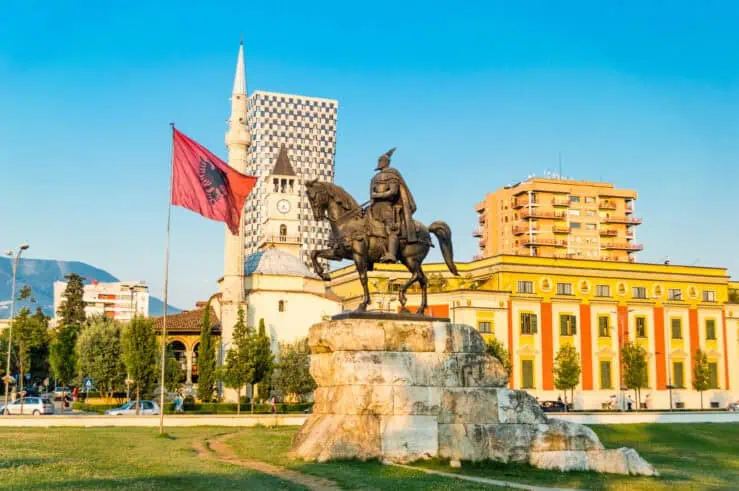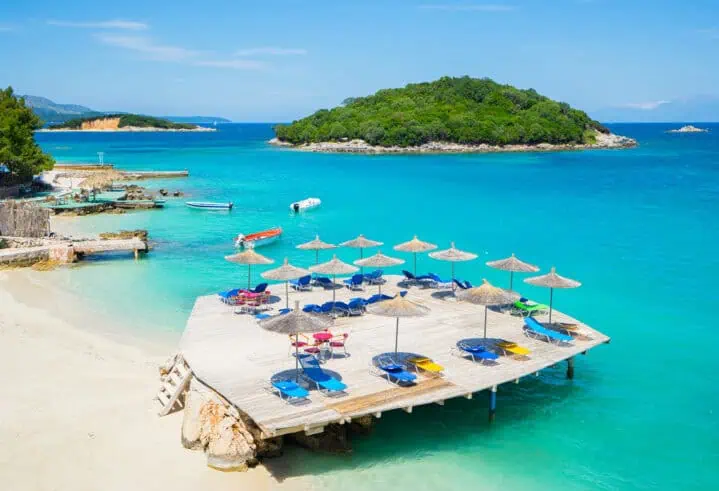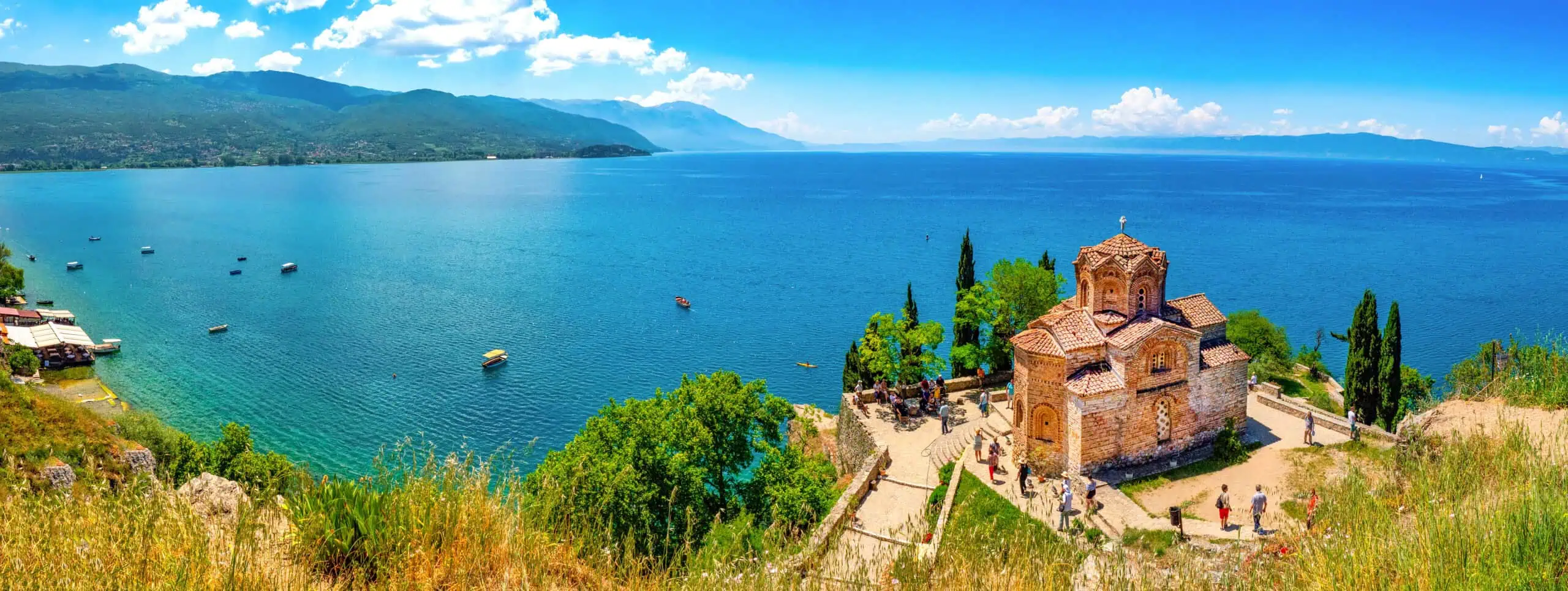Albania is a country that still flies under the radar. But that is changing. The country offers diverse scenery that rivals more famous European destinations, often without the crowds.
Among the country’s attractions are the crystal-clear waters and quiet beaches of the Ionian and Adriatic coasts, the dramatic mountain landscapes of the Albanian Alps, ancient ruins, Ottoman-era towns, and UNESCO World Heritage sites like Berat and Gjirokastër.
It’s also relatively more affordable for lodging and dining than popular European destinations. This 8‑day road trip captures the essence of Albania: cosmopolitan Tirana, dramatic coastal drives, olive‑lined beaches, and ancient ruins. If you’re short on time and want to visit this emerging tourism destination, here’s how to do it.
Days 1: Arrival & Discovery in Tirana

To Do:
- Explore Blloku: Once restricted to the political elite, this hip neighborhood is now packed with colorful street art, cafes, and nightlife.
- Cultural Stops: Visit the National History Museum or the Resurrection of Christ Orthodox Cathedral.
- Dinner spots: For traditional Albania cuisine in an upscale environment, visit Rossini Restaurant or Cafe Botanica.
- Evening stroll: Walk through the revitalized Grand Park or visit the nearby Tirana Zoo or the botanic garden.
Where to Stay in Tirana: Tirana International Hotel & Conference Centre or Tirana Marriott, two luxury hotels in the city center
Days 2: Berat
- Morning drive to Berat, the “City of A Thousand Windows” (~2 hours).
- Stroll through the Mangalem and Gorica quarters, where traditional Ottoman-era houses climb the hills on either side of the Osum River.
- Visit Berat Castle, a still-inhabited fortress with stunning views, Byzantine churches, and cobbled paths.
- Explore the Onufri National Iconographic Museum, located inside the castle, which showcases vivid Orthodox icons by Albania’s master iconographer.
- Taste local wine at Cobo Winery, just outside town, where you can sample indigenous grape varieties in a scenic vineyard.
- Walk along the Osum River Promenade.
- Where to Stay in Berat: Hotel Colombo Berat or Hotel Mangalemi
Day 3: Vlore and Llogara National Park
- Morning drive to Vlore (~1.5 hours).
- Spend a half-day on the beach.
- Afternoon in Vlore:
- Stroll along the Renaissance landmark–lined promenade and see the Monument of Independence.
- Optional visits: Muradie Mosque, Zvernec Island’s St. Mary’s Monastery, or the hilltop Kaninë Castle.
- After lunch, cross the coastal SH8 route and Llogara Pass to Llogara National Park. Step out to savor the panoramic views of the Ionian Sea—this mountain-to-sea transition is fantastic for photos. If time permits, head to Dhermi Beach.
- Evening journey to Borsh (~1–1½ hrs south) via scenic shoreline and olive groves.
- Where to Stay in Borsh: Options range from central boutique hotels to more tranquil hillside retreats near the beach. Sole Luna Hotel is a family-friendly beachfront property with a great beach bar and restaurant. Luna Mare Boutique Seaside Suites offers charming glamping cabins with private terraces overlooking the water.
Day 4: Borsh Beach
Borsh Beach: At over 7 kilometers long, it’s Albania’s longest beach—ideal for laid‑back sun lounging and swimming. Little commercialization makes it feel authentically relaxing.
- Activities:
- Rent sunbeds at “Carpe Diem” for a peaceful retreat by the sea.
- Visit Borsh Castle ruins atop Sopot Hill for sweeping coastal panoramas.
- Venture inland to Upper Qeparo for stunning village and mountain views.
- Boat charter to secluded coves like Krorëza Beach.
- A short hike to a local waterfall hidden in the greenery.
- Overnight in Borsh.
Days 5 and 6: Sarande and Ksamil

- Morning journey to Sarande (~1–1½ hrs south) via scenic shoreline and olive groves.
- Borsh Beach: At over 7 km long, it’s Albania’s longest beach—ideal for laid‑back sun lounging and swimming. Little commercialization makes it feel authentically relaxing.
- Activities:
- Explore Lëkurësi Castle at sunset – Perched on a hilltop since 1537, this Ottoman fortress offers panoramic vistas over Sarandë, the Ionian Sea, and even Corfu—plus a lovely on-site restaurant and bar for sundowners.
- Stroll Hasan Tahsini Boulevard & promenade – The lively seaside walkway is lined with cafés, shops, and market stalls where locals do their evening “xhiro” strolls. Perfect for savoring fresh seafood and sunset vibes.
- Dip into the Blue Eye (Syri i Kaltër) – Around 20 km inland, this intense azure karst spring plunges over 50 m deep. It’s a must‑see for nature lovers and photographers—just don’t miss the chance to visit early and avoid crowds.
- Discover ancient ruins – Wander through the ruins of Sarandë’s 5th‑century synagogue near the promenade and hike up to the 6th‑century Monastery of the Forty Saints, a serene spot with coastal views.
- Beach hop between Sarandë & Ksamil – From hidden coves like Shpella e Pellumbave to family‑friendly Pulëbardha Beach, the stretch south of town is full of crystal‑clear water and sandy spots begging for snorkeling or sunbathing.
- Take a semi‑submarine or boat tour – Explore underwater life, reefs and shipwrecks in the Karaburun‑Sazan Marine Park—or hop on a boat to the Ksamil islets for a dreamy coastal escape. Rent sunbeds at Carpe Diem.
- Visit Borsh Castle ruins atop Sopot Hill for sweeping coastal panoramas.
- Venture inland to Upper Qeparo for stunning village and mountain views.
- Where to Stay in Sarande:
- The Queen’s Lion Premium Hotel: Modern oceanfront hotel near Hasan Tahsini Boulevard.
Day 7: Travel to Tirana
Begin the scenic drive back to Tirana, allowing ~4 hours. If time allows:
- Stop in Vlore for a coastal lunch stroll, or visit Apollonia archaeological site near Fier to explore ancient Roman and Greek ruins.
- Evening return: Drop off the rental car and enjoy your final night back in Tirana—optionally back at the Marriott or a Blloku boutique stay. Alternatively, you can spend one to two nights in Durres, a seaside city only 30 minutes from Tirana
Day 8: Depart from Tirana
Transfer to the airport for your flight home.
Insider Tips
- Driving: Narrow mountain roads, especially around Borsh and Llogara. Budget extra time and watch for goats and cyclists.
- Currency: Have cash (lek) on hand for smaller towns—credit cards are less accepted there.
- Crowd timing: Visit Blue Eye Springs, Butrint, or other popular sites early or late to beat the midday rush.
- Local culture: Dress modestly at religious sites (monasteries, mosques). Try learning simple Albanian greetings to connect with locals.
Where is Albania?
A short drive or hop from neighboring Greece, Albania is a small country located in Southeastern Europe on the Balkan Peninsula. Bordered by Montenegro to the northwest, Kosovo to the northeast, North Macedonia to the east, and Greece to the south, it also boasts a stunning western coastline along the Adriatic Sea and a southern coastline along the Ionian Sea. This unique geographic position gives Albania a diverse landscape of rugged mountains, fertile valleys, and pristine beaches. Its location also places it at a cultural crossroads between Western Europe and the Eastern Mediterranean, contributing to its rich historical and cultural heritage.
Is Albania Safe?
Yes, Albania is generally considered a safe country for travelers. Violent crime is rare, especially in tourist areas, and locals are known for their hospitality and warmth toward visitors. While petty theft, like pickpocketing, can occur in crowded places—as in any country—basic precautions such as keeping valuables secure and staying aware of your surroundings are usually sufficient. Road conditions in some rural areas can be challenging, so cautious driving is advised. Overall, with a little common sense, travelers typically find Albania to be a welcoming and secure destination.
This post may contain affiliate links, which means that we may receive a small amount of income if you click the link and purchase something we have recommended. Clicking these links won’t cost you any extra money, and all opinions remain our own.










